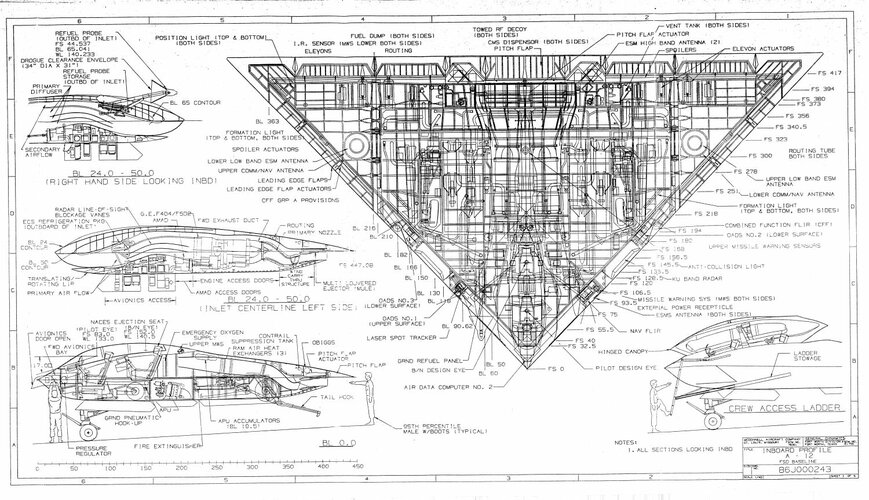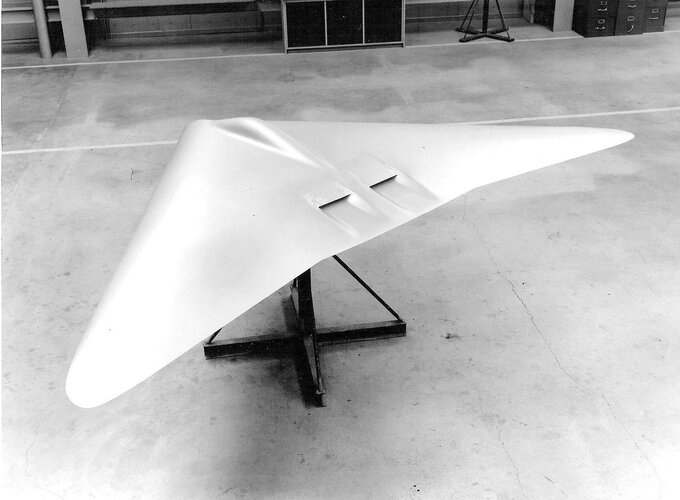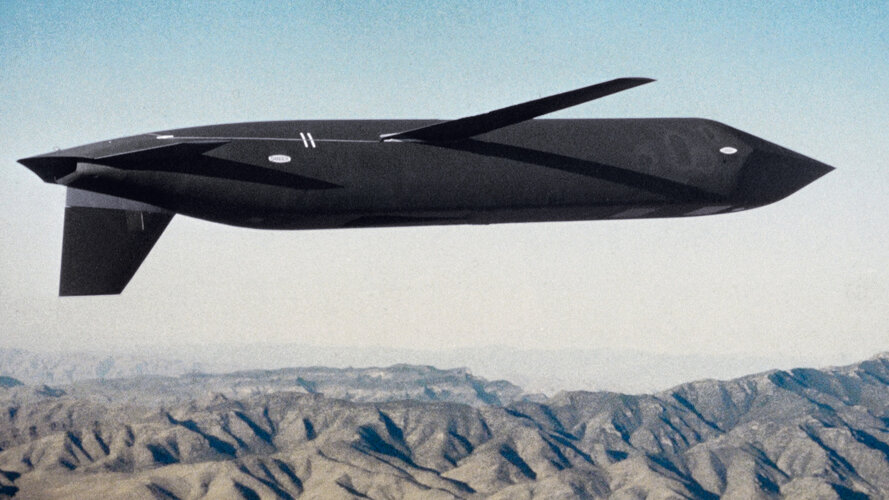In June, Keith Jackson was told the Have Key was considered a direct threat to the ATF Program.
Despite Jackson saying his team were 'stealth specialists' and the USAF saying Have Key was a threat to ATF which rapidly necked down to being both stealth AND supersonic.
Whether is sabotage of Grumman, Navy Strike or the A-6 specifically: 'Lehman is given The Word by Thayer, to begin looking at a 'new airplane' to replace the A-6. It is understood that 'New' means stealth. Lehman says 'Aye Aye Sir!' and begins to establish a Blue Ribbon commission, filled with naval and marine aviators to kill the proto A-12.
Lehman says, somewhere in the text, that _his view_ of the ATA was a special squadron, kept somewhere remote in the desert, training against threat complexes, then flown out to the boat, at need, as a pathfinder force. Where they could target for the MRASM or TASM or whatever.
The A-12's chief opponent in the Navy wanted it to be a pathfinder, even though, by his own consideration, it was only a 34 million dollar platform compared to the 28 million dollar A-6F that was his heart's true desire and so he could have afforded both. Because he didn't need more than about 50-100 'new' jets.
...it stands to reason that that company which put together a specific VLO engineering team at the very beginning of the 1980s, would be designing a VLO specific platform for the Navy. A flying wing with extremely short pitch couple and large float is not your first choice for a carrier landing airframe with high sink rates and the need for precision scatter control on a narrow angle deck.
Who does this? FOIA. The Family Of Intelligence Agencies. Trying to break into stealth.
Model 100 _did_ catch someone's attention as Jackson shopped it around. But it wasn't the uniformed service's eye. They were just a cover.
But not Bravery. Whose trigram is straight out of the Intel world.
Leg, I'd like to opine and speculate on a few of what I'm interpreting your questions/concerns are, and/or what your BS meter is detecting. Like I wrote above, understanding the behind-the-scenes drama of the Navy ATA and Air Force ATF programs has been a quest of mine for 30+ years. [I have no burning interest in the ATB history, but I've found Cashen's and Waaland's oral histories (Huntington Library) fit what I've picked up -- Ben Rich's, eh, not so much.]
For simplicity I'll use the term "dorito chip" to apply to any of the GD designs (Model 100/Sneaky Pete/VX-11/Cold Pidgeon/ATA/A-12A) with the characteristic shape of an isosceles triangle and a 46-deg leading edge sweep. The dorito chip may or may not have an afterburner, depending on the application. So, in no particular order....
**Did Keith Jackson and GD promote the dorito chip with afterburner as a supersonic-capable ATF candidate?
An unqualified yes, and very aggressively to boot. However, a dorito chip with or without an afterburner was not considered a compliant alternative from the vantage point of the ATF requirement officers and acquisition folks, primarily due to its inability to supercruise, and its inability to perform the supersonic turn (in dry power) fundamental to "first look, first shot, first kill". I'll add that an afterburning dorito chip has impressive transonic maneuver performance, which were requirements in both AF ATF and Navy VFMX.
**Why did USAF view the GD dorito chip as a threat to ATF?
Well, the USAF is not a monolith. Lots of pieces and fifedoms. The point I want to emphasize is that only a flight-demo'd dorito chip would have given GD the opportunity to sell their wares and cause disruption. A dorito chip that was merely a paper drawing in a Powerpoint briefing would not open-up avenues that bypass the DoD mainstream of requirements generation and system acquisition.
**Why was Have Key (presumably 1976-1983) considered a threat to ATF?
It was a "confusion grenade". As quellish has often pointed out, the ASD shop working Have Key was not aware of the DARPA/USAF activities under Have Blue and Tacit Blue. No reason to kill Have Key until it reaches a natural end-state, i.e. a flight demonstration. By 1982 or so, those not privvy to ATF special access activities, in the Pentagon and in Congress, may start asking questions like "why isn't ATF embracing Have Key technology maturation efforts".
I describe Have Key as more of a P.I.T.A. than a threat, from the P.O.V. of Air Force leadership.
**Who then viewed the GD dorito chip as a genuine threat to the ATF program?
Primarily the ATF SPO prior to Milestone II approval in 1991, fearing that further delays caused by OSD and/or Congress wanting to re-plow old ground -- after all, the ATF pre-development phase had already gone on for 10 years.
But I strongly suspect that GD-FW did not stop their business development push with the July 1991 EMD contract award, even though GD-FW was a teammate of Lockheed and Boeing. I know that F-22 leadership (SPO and Lockheed) had significant concerns about GD's commitment to the F-22 program in 1992. I know that the SPO, Lockheed and Boeing were beginning to make contingency plans if the EXCOM (L and B CEOs plus AF CoS) gave the go-ahead to kick GD off the team. Why??? I can only attribute these activities to a relentless and unending push by GD to offer an F-22 alternative.... my guess is GD was selling a mix of F-16 derivatives (F-16XL variants) with an afterburning dorito chip, and advertizing it as a much more cost effective, multi-mission force than the air-to-air dedicated F-22A.
**Re ATA, what were Lehman's motives and priorities?
First and foremost, Lehman wanted to protect USN deep strike capability. He initially went the A-6F route (btw, it carried a couple of Sidewinders, just like ATA required a bit later). My guess at the time was that, as SECNAV, he got an opportunity to learn of Senior Trend and Senior Ice/Cejay, and when he saw the emerging F-117 and B-2 he shouted "I want that on my carriers ASAP."
In my mind, Lehman desperately wanted to meet or beat the B-2 to IOC. Why? Because, back then, the Air Force was trying to convince Congress that a large fleet of ATB’s could hold the same Soviet targets at risk as a dozen Carrier Battle Groups, but for a lot less money. [I believe there’s a lot of truth in that today - - > more B-21s and less Carrier Strike Groups].
So I don't subscribe to the narrative that OSD (Thayer, et al) rammed ATA down Lehman's throat. But Lehman, as sophisticated a politico as the come (he did staff for Kissinger after all), had already put the wheels in motion for the A-6F, and knew he didn't have the budget to do both A-6F and ATA -- so he was in a pickle. And as any good politician would do, when ATA/A-12 went south, he put out the word that he was always wanted an A-6F and was not in hurry to go the next step to stealth, better to wait till the USAF works out the technological bugs...
**Was ATA an opportunity to put Grumman out of business?
Grumman put itself out of business. I could devote an entire thread to that topic, but I won't.
Back to ATA, Lehman personally visited Grumman-Bethpage on July 6, 1984, on his way to a belated July 4th weekend at Martha's Vineyard. The Stephenson book and the Skurla/Gregory book chronicle that watershed moment. I would add to those published accounts, that Lehman's sole purpose for visiting Grumman that day was to tell them directly "I want you to fly west and talk to Northrop" [my source: one of the folks in the SCIF conference room -- attendees: Lehman, Skurla, 3 or 4 VPs, and 2 younger guys being groomed for VP].
By all accounts, Lehman was very fond of Grumman. In the SCIF, he told them, in so many words, that they missed the stealth boat, but
I need you to put a tailhook on a mini-B-2.
As far as I can gather, Grumman was the next place he personally visited after going to LA to see Northrop and Lockheed. There's no indication that he visitied GD-Fort Worth or McAir-St Louis, but we know from Stevenson that he sent Paisley to talk to McAir later in September.
ATA was Northrop and Grumman's program if they wanted it -- the public record and various post-mortems explain that the fixed-price contract with an inadequate Navy budget wedge, along with the idea of competitive production, was enough for N-G to later say "no thanks", which is not much different than what Lockheed's initial reading was in mid-1984.
Finally, the idea of a silver bullet force of ATAs out in the desert, is contradicted by the Navy's plan from the start to compete production between teammates. This special squadron talk is just Lehman's spin after A-12 collapsed.
**Why did GD stand-up an LO engineering team around 1980?
Simple -- to design and build a technology flight demonstrator. My guess is that the
likely-but-unconfirmed Have Key aircraft was subscale, non-afterburning, and just 'shaped' for low RCS, intended to demonstrate tailless aircraft control, maneuverability, and to validate the predicted drag and inlet/nozzle performance. I'd bet that there also was a large-scale or full-scale pole model, either tested at RATSCAT or GD's Fort Worth facility. [not to get into stealth levels, but the 'noise' and pylon construction at RATSCAT or GD's facility must be compatible with the target's expected return].
**Did the spooks have an interest in the dorito chip?
Well, this reminds me of my relative who believes that the airliner flying overhead is spewing out 'chem trails'.
The CIA has long history of going direct to the prime contractors. As quellish has often pointed out, Quartz was underway before ATA began. Much before that, Kelly Johnson's Gusto II design was his attempt at 'SLO'.



